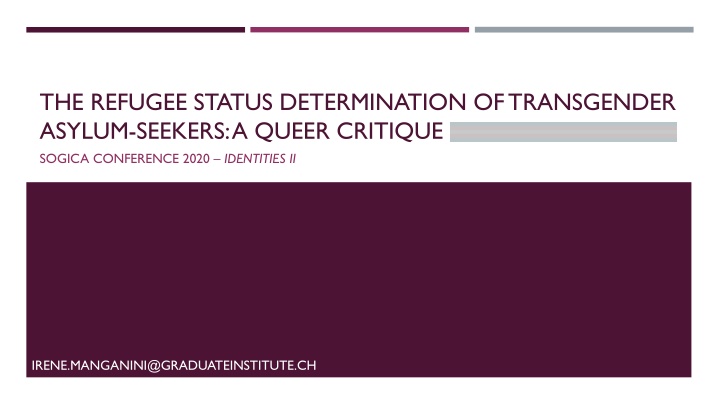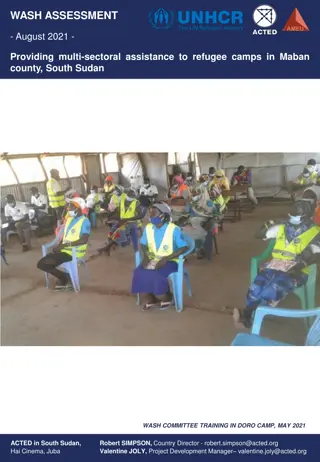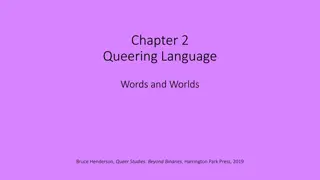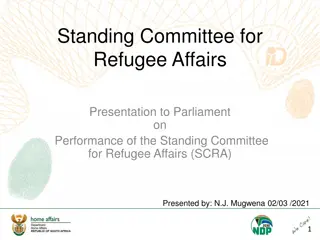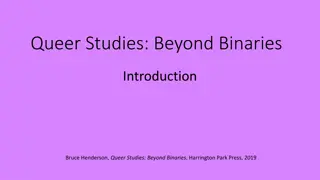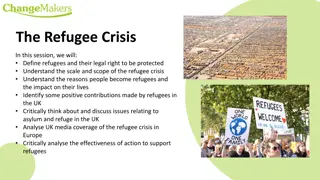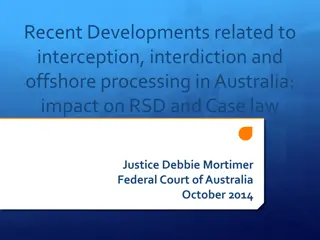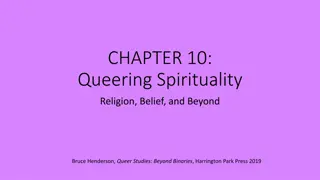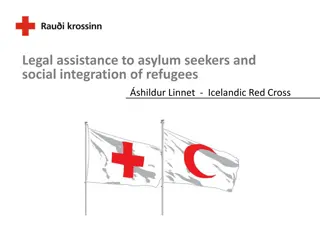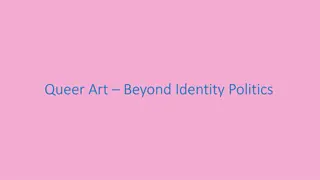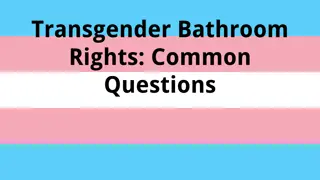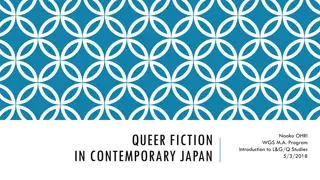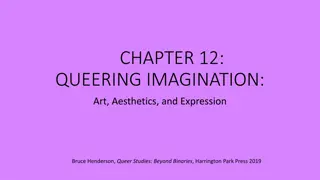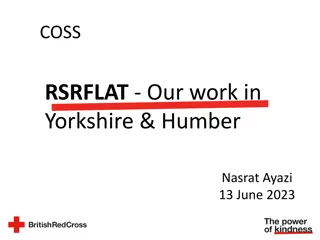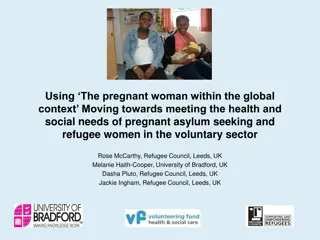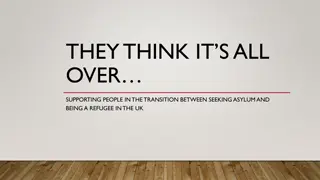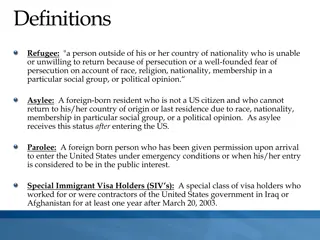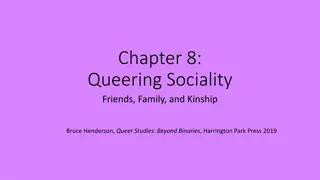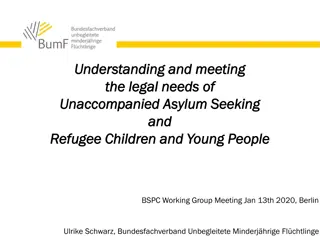Queer Critique of Transgender Asylum-Seeker Refugee Status Determination
Exploring the challenges faced by transgender asylum-seekers in the global asylum system through a queer analysis of the refugee status determination process. Discusses the misinterpretations of UNHCR guidelines related to gender identity, highlighting the marginalization and risks faced by transgender individuals. Emphasizes the need for rethinking and improving the asylum process to ensure the protection of transgender rights and experiences.
Uploaded on Oct 10, 2024 | 0 Views
Download Presentation

Please find below an Image/Link to download the presentation.
The content on the website is provided AS IS for your information and personal use only. It may not be sold, licensed, or shared on other websites without obtaining consent from the author.If you encounter any issues during the download, it is possible that the publisher has removed the file from their server.
You are allowed to download the files provided on this website for personal or commercial use, subject to the condition that they are used lawfully. All files are the property of their respective owners.
The content on the website is provided AS IS for your information and personal use only. It may not be sold, licensed, or shared on other websites without obtaining consent from the author.
E N D
Presentation Transcript
THE REFUGEE STATUS DETERMINATION OF TRANSGENDER ASYLUM-SEEKERS: A QUEER CRITIQUE SOGICA CONFERENCE 2020 IDENTITIES II IRENE.MANGANINI@GRADUATEINSTITUTE.CH
RESEARCH QUESTION How can a queer analysis of the refugee status determination process of transgender asylum-seekers help in showing us the way forward to rethink the global asylum system?
PRESENTATION The law as it is - UNHCR definition of transgender What goes wrong during its application patterns of recurrent misinterpretations Why does this happen brief queer analysis
Transgender describes people whose gender identity and/or gender expression differs from the biological sex they were assigned at birth. Transgender is a gender identity, not a sexual orientation and a transgender individual may be heterosexual, gay, lesbian or bisexual. Transgender individuals dress or act in ways that are often different from what is generally expected by society on the basis of their sex assigned at birth. Also, they may not appear or act in these ways at all times. For example, individuals may choose to express their chosen gender only at certain times in environments where they feel safe. Not fitting within accepted binary perceptions of being male and female, they may be perceived as threatening social norms and values. This non-conformity exposes them to risk of harm. Transgender individuals are often highly marginalised and their claims may reveal experiences of severe physical, psychological and/or sexual violence. [ ] UNHCR DEFINITION UNHCR GUIDELINES ON INTERNATIONAL PROTECTION RELATED TO CLAIMS TO REFUGEE STATUS BASED ON SEXUAL ORIENTATION AND/OR GENDER IDENTITY [GUIDELINES N.9]
Transgender describes people whose gender identity and/or gender expression differs from the biological sex they were assigned at birth. Transgender is a gender identity, not a sexual orientation and a transgender individual may be heterosexual, gay, lesbian or bisexual. Transgender individuals dress or act in ways that are often different from what is generally expected by society on the basis of their sex assigned at birth. Also, they may not appear or act in these ways at all times. For example, individuals may choose to express their chosen gender only at certain times in environments where they feel safe. Not fitting within accepted binary perceptions of being male and female, they may be perceived as threatening social norms and values. This non-conformity exposes them to risk of harm. Transgender individuals are often highly marginalised and their claims may reveal experiences of severe physical, psychological and/or sexual violence. [ ] UNHCR DEFINITION UNHCR GUIDELINES ON INTERNATIONAL PROTECTION RELATED TO CLAIMS TO REFUGEE STATUS BASED ON SEXUAL ORIENTATION AND/OR GENDER IDENTITY [GUIDELINES N.9]
Transgender describes people whose gender identity and/or gender expression differs from the biological sex they were assigned at birth. Transgender is a gender identity, not a sexual orientation and a transgender individual may be heterosexual, gay, lesbian or bisexual. Transgender individuals dress or act in ways that are often different from what is generally expected by society on the basis of their sex assigned at birth. Also, they may not appear or act in these ways at all times. For example, individuals may choose to express their chosen gender only at certain times in environments where they feel safe. Not fitting within accepted binary perceptions of being male and female, they may be perceived as threatening social norms and values. This non-conformity exposes them to risk of harm. Transgender individuals are often highly marginalised and their claims may reveal experiences of severe physical, psychological and/or sexual violence. [ ] UNHCR DEFINITION UNHCR GUIDELINES ON INTERNATIONAL PROTECTION RELATED TO CLAIMS TO REFUGEE STATUS BASED ON SEXUAL ORIENTATION AND/OR GENDER IDENTITY [GUIDELINES N.9]
REFUGEE STATUS DETERMINATION WELL-FOUNDED FEAR Concealment Someone who: owing to wellfounded fear of being persecuted for reasons of race, religion, nationality, membership of a particular social group or political opinion, is outside the country of his nationality and is unable or, owing to such fear, is unwilling to avail himself of the protection of that country; or who, not having a nationality and being outside the country of his former habitual residence as a result of such events, is unable or, owing to such fear, is unwilling to return to it. HJ (Iran) and HT (Cameroon) v Secretary of State for the Home Department [2010] Country of origin information No. 02/94109 (Rechtbank) [2004] Late disclosure (sur place claims) A (C-148/13), B (C-149/13) and C (C-150/13) v Staatssecretaris van Veiligheid en Justitite, Judgment, ECJ Grand Chamber [2014]
REFUGEE STATUS DETERMINATION PERSECUTION Someone who: owing to wellfounded fear of being persecuted for reasons of race, religion, nationality, membership of a particular social group or political opinion, is outside the country of his nationality and is unable or, owing to such fear, is unwilling to avail himself of the protection of that country; or who, not having a nationality and being outside the country of his former habitual residence as a result of such events, is unable or, owing to such fear, is unwilling to return to it. Criminalisation X, Y and Z v Minister voor Immigratie en Asiel, No. C-199/12-C- 201/12, ECJ, [2013]
REFUGEE STATUS DETERMINATION THE CAUSAL LINK Someone who: owing to wellfounded fear of being persecuted for reasons ofrace, religion, nationality, membership of a particular social group or political opinion, is outside the country of his nationality and is unable or, owing to such fear, is unwilling to avail himself of the protection of that country; or who, not having a nationality and being outside the country of his former habitual residence as a result of such events, is unable or, owing to such fear, is unwilling to return to it. For reasons of S. Ardalan and D. Anker Escalating Persecution of Gays and Refugee Protection: Comment on Queer Cases Make Bad Law (Rochester, NY: Social Science Research Network, 2012).
REFUGEE STATUS DETERMINATION MEMBERSHIP OF A PARTICULAR SOCIAL GROUP Someone who: owing to wellfounded fear of being persecuted for reasons of race, religion, nationality, membership of a particular social group or political opinion, is outside the country of his nationality and is unable or, owing to such fear, is unwilling to avail himself of the protection of that country; or who, not having a nationality and being outside the country of his former habitual residence as a result of such events, is unable or, owing to such fear, is unwilling to return to it. Credibility No. T94- 07129 (Canada, 1995)
REFUGEE STATUS DETERMINATION STATE PROTECTION Someone who: owing to wellfounded fear of being persecuted for reasons of race, religion, nationality, membership of a particular social group or political opinion, is outside the country of his nationality and is unable or, owing to such fear, is unwilling to avail himself of the protection of that country; or who, not having a nationality and being outside the country of his former habitual residence as a result of such events, is unable or, owing to such fear, is unwilling to return to it. Internal relocation alternative UNHCR, Guidelines on International Protection No. 4: Internal Flight or Relocation Alternative Within the Context of Article 1A(2) of the 1951 Convention and/or 1967 Protocol Relating to the Status of Refugees, HCR/GIP/03/04 (2003)
Queer legal theory provides a means to examine the structural assumptions and conceptual architecture that underpin the normative framework and operation of international law. The critical insights of queer theory can offer new insights into how international law works to reinforce unequal relations of power, resources and knowledge, and how this might be resisted. Dianne Otto, Queering International Law: Possibilities, Alliances, Complicities, Risks, Routledge Research in International Law (Abingdon, Oxon; New York, NY: Routledge, 2017). QUEER LEGALTHEORY
POWER STRUCTURES UNDERPINNINGTHE ASYLUM SYSTEM Border Gender binary Western cultural supremacy
POWER STRUCTURES UNDERPINNING THE ASYLUM SYSTEM Border Gender binary Western cultural stereotype
POWER STRUCTURES UNDERPINNINGTHE ASYLUM SYSTEM Border Gender binary Western cultural supremacy
POWER STRUCTURES UNDERPINNINGTHE ASYLUM SYSTEM Border Gender binary Western cultural stereotype
Queering international refugee law CONCLUSION
THANK YOU! IRENE.MANGANINI@GRADUATEINSTITUTE.CH
